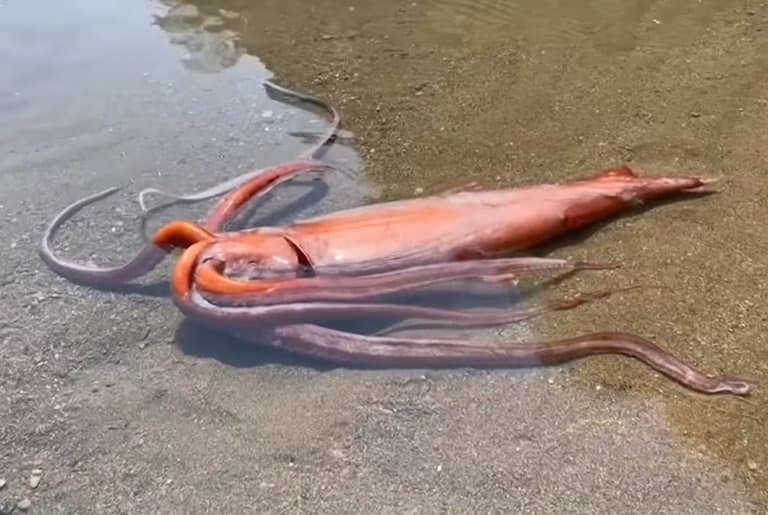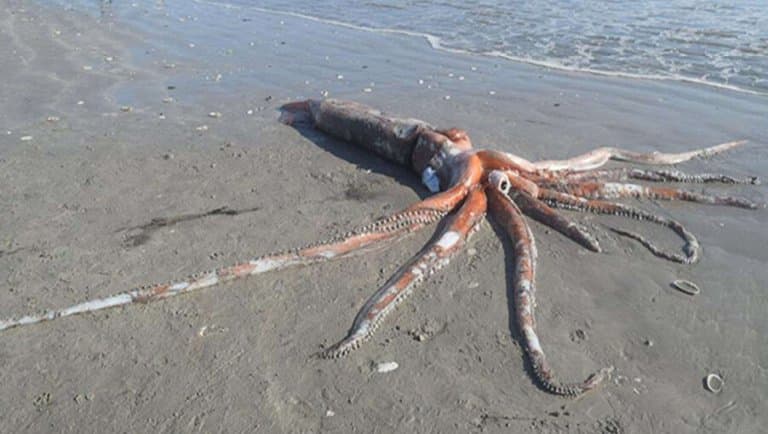Giant Squid Profile
There’s an animal that has inspired legends since the dawn of seafaring humans. It’s a Kraken from the deep, with long tentacles and enormous eyes, and a powerful crushing beak, yet it has no bones and hunts its prey in the inky depths of the ocean.
Nobody knows how deep it lives; in fact, nobody knows much about it at all, and only a handful have ever been seen alive. This is the giant squid, and it’s one of the most frightening mysteries of the deep yet to be explained.

Giant Squid Facts Overview
| Habitat: | Deep waters, perhaps <1,000m |
| Location: | Worldwide |
| Lifespan: | Unknown, possible at least 14 years |
| Size: | At least 20m |
| Weight: | Over 275 kg (606 lb) |
| Color: | Grey, iridescent silver/gold, possibly colour-changing |
| Diet: | Fish, crustaceans, other squid |
| Predators: | Sperm whales |
| Top Speed: | Unknown |
| No. of Species: |
1 |
| Conservation Status: |
Least concern |
The giant squid is widespread across all oceans, particularly in the North and South Atlantic, and southwestern Pacific ocean. Like all squid, a giant squid has a mantle (torso), eight arms, and two longer tentacles.
The giant squid is one of the largest invertebrates on earth. Despite this, it remained undocumented other than from remains inside the stomachs of the largest predator on earth: the sperm whale.
In 2013, footage of a live animal was finally captured, and scientists are slowly piecing together the puzzle of this elusive animal.
While we know so little about these animals, we can infer from samples many things that would be impossible to witness in the wild. Still, these are, at best, educated guesses and much more remains to be discovered about this semi-mythical beast from the abyss.
Interesting Giant Squid Facts
1. They’re Gigantic
This isn’t just a comment on their impressive size, it’s also a reference to a biological adaptation known as ‘gigantism’.
The deep sea isn’t very well studied, but it’s thought that food down there is incredibly scarce. Why, then, would an animal like this squid, and many other deep-sea animals evolve to be enormous?
One issue is the temperature. One of the first places gigantism was studied was in the frigid shallow waters of Antarctica, where numerous animals have adapted to the freezing water by growing large.
Increased mass means there is less surface area relative to body size, and that means less space for heat exchange to occur. As a result, larger animals can stay warm for longer. This adaptation serves a similar purpose in the deep, where temperatures are around 4 degrees C.
The other reason being large is an advantage is that it gives an animal a lot more locomotion. A big animal like the giant squid can swim a lot farther and faster using relatively less energy than a tiny counterpart would, which means it can better hunt for that scarce food. Compared with animals in warmer climates or with warmer blood, squid have a slower metabolism, meaning they don’t need to eat as much. 1
2. They’re enigmatic
This is a bit of an understatement. Until recently there were so few specimens to go on, and what was collected was generally preserved from whale stomachs or what had washed up on beaches.
Still, from these samples, it has been possible to form a draft genome of the animal, measure the concentrations of different minerals in their beaks and itemize the gut contents of more complete specimens. From these, it’s possible to make a bunch of extrapolations, but before we get to those, let’s take a look at what we don’t know.
3. They have the longest tentacles of any squid
These make up most of their amazing length, and the tentacles have hundreds of suction cups between 2-5 cm in size.
They are outlined in serrated rings of chitin, which allow the giant squid to attack prey and defend itself against predators, which can include sperm whales, killer whales and sharks.
4. Their lifespan is an unknown
It’s thought that they reach sexual maturity around 3 years old, but the top age can’t be determined. Giant squid have a built-in accelerometer that works like your inner ear, in which a mineralised deposit moves around inside a sensory organ to tell it which way up it’s facing.
This deposit, or statolith, increased in size as the animal ages, and by counting the layers, it’s possible to guess how old they are. The beaks also increase in size over time, and from both of these inputs, the oldest specimen found was estimated to be about fourteen years old. However, we have no idea how much older they can get, and even these measurements are subject to a lot of assumptions. 2

5. When giant squids mate, it’s a stab in the dark
From a single female specimen, it has been inferred that the male injects pressurised sperm into the arms of the female with its metre-long penis. So far, this is our best guess.
What happens next is equally a mystery. Where the eggs end up, or how they hatch, we have nothing to infer from. 3
6. There’s somewhere between 1 and 8 species!
Some people guess there are up to eight in the Architeuthis, others other think there’s just one. Genetric research suggests that there is likely one species, but nobody really knows.
We don’t even know how many individuals there are, or whether they congregate, although it is inferred by deliberately-timed sperm whale hunting expeditions that mating groups come together under some circumstances.
7. Giant squid are estimated to grow up to 20 meters
Well guess what: we don’t know really know this either. Estimates of up to 20 meters, based on beak sizes inside sperm whales only tell half the story. Other more recent studies suggest they might grow between 12-13m (40 – 45 ft).
As with many deep-sea animals, they could descend farther as they get bigger, to the point at which there’s just one really big giant squid sitting on the ocean floor like the demon queen of the deep.
But again, this is speculation, and not very intelligent speculation as that. This makes them longer, but lighter than the colossal squid.

8. They eat squid
This is a relatively easy one. They eat other squid. Including members of their own species. We know this because we’ve seen inside the guts of some of them. Generally, all you get when you look inside a giant squid is a fish scale or two, some crab and bivalve shells and some ambiguous squid goo.
However, a specimen dissected in 2003 offered up a little more detail.
In this giant squid were the remains of its conspecifics. Pieces of arm from another giant squid, hinting at a cannibalistic, and likely, therefore, solitary animal.
Pebbles, algae and cestodes (tapeworms) have also been found inside a squid, further confirming that tapeworms will eventually find you, wherever you live.
9. They can regrow their arms
This has been witnessed in one specimen from Newfoundland, in 1968, around the time when, for unknown reasons, these animals were washing up in droves.
The individual showed signs of regeneration at the end of its arm, in the form of an immature stage of arm development.
Of course, this could have been a malformed specimen, but it’s thought it compares with other forms of regeneration in similar animals.
10. They have the largest eyes in the world
Possibly the largest eyes ever to have existed. Along with the colossal squid, these giants break the record for the largest diameter of any eye measured, at around 30cm, or one foot across.
It’s thought that they have such enormous eyes to spot descending giants as they come to feed. 4
11. They fight sperm whales
The largest carnivore on earth has a hankering for giant squid. It’s from the belly of these giants that we get much of the giant squid information we have.
And from the scars on the faces of many sperm whales, it’s obvious that the squid knows how to put up a fight.
Giant squid have enormous suckers lined with small, sharp teeth that leave a distinctive suction cup mark on the faces of their predators.
Giant Squid Fact-File Summary
Scientific Classification
| Kingdom: | Animalia |
| Phylum: | Mollusca |
| Class: | Cephalopoda |
| Order: | Oegopsida |
| Family: | Architeuthidae |
| Genus: | Architeuthis |
| Species Name: |
Architeuthis Dux |
Fact Sources & References
- Donavyn Coffey (2022), “Why are there so many giants in the deep sea?“, Live Science.
- J. K. Cochran, R. Cerrato, J. Mak, C. F. E. Roper & C. C. Lu (2004), “Habitat and age of the giant squid (Architeuthis sanctipauli) inferred from isotopic analyses“, Marine Biology.
- William J Broad (1997), “When Giant Squids Mate, It’s a Stab in the Dark“, New York Times.
- Dan-Eric Nilsson (2012), “A Unique Advantage for Giant Eyes in Giant Squid“, ScienceDirect.
